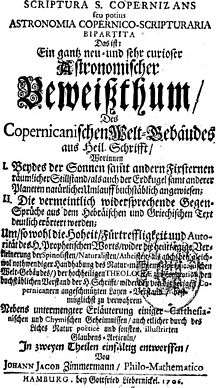Johann Jacob Zimmermann

Johann Jacob Zimmermann (November 25, 1642 – 1693) was a German nonconformist theologian, millenarian, mathematician, and astronomer.
Life

Zimmerman was born in Vaihingen, Württemberg (now Germany) on November 25, 1642.[1] He lived in Nürtingen, and studied theology at the University of Tübingen, where he was awarded the title Magisterhut in 1664. An astronomer and astrologer, Zimmerman produced one of the first Equidistant Conic Projection star charts of the northern hemisphere in 1692. While at University, he also was a singing instructor.[1]
He took his first post as a Lutheran minister at Bietigheim (Baden) in 1671, but already was developing a reputation through his scientific and occult writings, publishing under the name Ambrosius Sehmann. In 1685, Zimmermann was removed from his post by Lutheran church leaders, in part for his Scriptura Sacra Copernizans, which defended the astrological theories of Nicolaus Copernicus. As a testimony to his importance as a scientific writer, the work was reprinted in Hamburg in 1707, this time under Zimmermann's own name.[2]
Traveling to Frankfurt on Main, he became a follower of Jakob Böhme, a Pietist pastor and prominent critic of the established Lutheran church. Zimmermann made a living as a writer and teacher, and gradually developed a following in the city of Hamburg, creating elaborate theories predicting the end of the world. In his Muthmassliche Zeit-Bestimmung, Zimmermann set out his belief that the apocalypse would occur on the "edge of the wilderness" at the end of the autumn of 1693.[1] His work centered on an elaborate textual and numerological interpretation of the biblical Book of Revelation, especially chapter XII. Zimmerman planned to lead his followers to North America to build a "Society of the Woman in the Wilderness" to greet the dawn of this new world. His group, termed Rosicrucians, were to number 40, and were to lead a largely solitary life practicing astrology, astronomy, geomancy and a variety of arcane mathematical and magical forms of divination. Zimmermann began negotiations with Pennsylvania Governor William Penn to obtain land for his settlement.
Zimmerman died as the group of eleven families were preparing to travel from Rotterdam. His disciple Johannes Kelpius was elected to take Zimmermann's title of magister, leading "the Hamburg Group" (including Zimmermann's widow) to an area near Wissahickon Creek, Pennsylvania. Here they established a religious community which, while still famed in local legend, dissolved shortly after Kelpius' death in the early eighteenth century.
Zimmerman is mentioned (as Dr. Zimmerman) in Book 3 of Isaac Newton's Philosophiæ Naturalis Principia Mathematica in 1687(on p. 505) as having observed the Great Comet of 1680.[1]
Johann Jacob Zimmermann believed a person's close relationship with God was more important than having a close relationship with the church, believing most, if not all, of the churches in Europe were corrupt. He believed the wonders in the sky were signs of the end times, and felt a change would occur in 1693. Instead, Zimmermann died in 1693 at the age of 50. An old German letter stated that Zimmermann died en route to America and was buried in Rotterdam. It also stated that the writer of the letter had begged Zimmermann not to go.[1]
Legacy
Josh Groban, singer, is the 8 times great grandson of Johan Zimmerman.[1]
See also
References
- 1 2 3 4 5 6 "Who Do You Think You Are?", tracing lineage of Josh Groban back to his 8th grandfather, Johann Jacob Zimmermann
- ↑ "Die Kunstrechner". Retrieved 29 January 2013.
Works
- Auf alle und jede Hypotheses applicable Fundamental-Aufgaben von den Sonn- und Mond-Finsternisssen. Hamburg 1691
- Coniglobium...Eine vortheilhafftige und nach dem...Hevelianischen Gestirn-Register eingerichtete...Himmelskugel. Hamburg 1704
- Muthmassliche Zeit-Bestimmung...Göttlicher Gerichten über das Europeische Babel. o.O. 1684
- Scriptura S. Copernizans...Astronomischer Beweissthum des Copernicanischen Welt-Gebäudes. Hamburg 1690
- Collection: Aktuelles Verzeichnis der Werke Zimmermanns im VD17
Sources
- German Wikipedia: "Johann Jacob Zimmermann"de:Johann Jacob Zimmermann
- Encyclopedia Universalis: http://www.universalis.fr/corpus-universalis/1//T232294/universalis/article.htm
- "German-American Yesteryears: Johannes Kelpius, The Maddest of Good Men" By Robert A. Selig, June/July 1999 : http://www.germanlife.com/Archives/1999/9906_01.html
- "Horologium Achez" by Julius Sachse, in Proceedings of the American Philosophical Society, Vol. XXXIV, January, 1895. ISBN 1-4223-7358-4
- Gerhard Dünnhaupt: "Johann Jacob Zimmermann (1644-1693)", in: Personalbibliographien zu den Drucken des Barock, Bd. 6. Stuttgart: Hiersemann 1993, S. 4344-55. ISBN 3-7772-9305-9
- Mike A. Zuber, 'Copernican Cosmotheism: Johann Jacob Zimmermann and the Mystical Light', Aries 14.2 (2014)